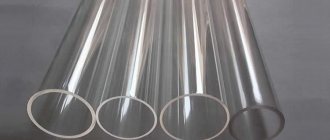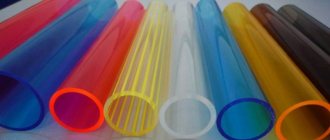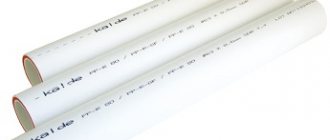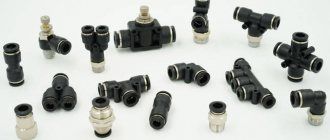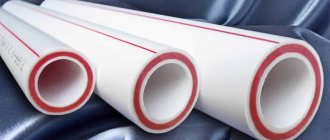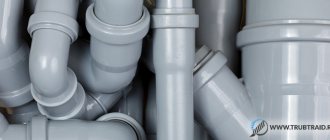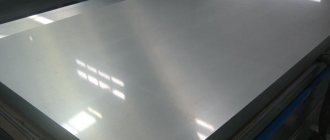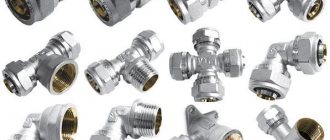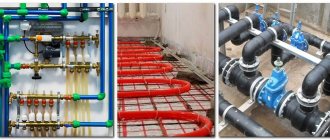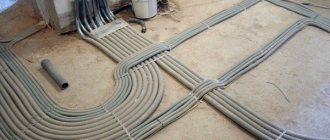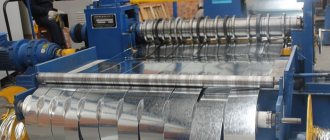Pipes made of low-density polyethylene (HDPE) can be of various colors, with or without markings. As for the technical pipe, in most cases it is black. Non-pressure black HDPE pipe has found wide application in the construction and repair of communications. Technical black pipes are indispensable when laying cables inside buildings and underground: they can withstand high loads, are an excellent insulator and prevent condensation. In addition, a large diameter black HDPE pipe is suitable for creating a free-flow sewer system.
You can buy a black polyethylene pipe directly from the factory. At your request, the pipe will be cut into the required lengths or wound onto a coil of the required length. The price of a black pipe per meter or kg depends on the volume, but no matter how many meters you order, the cost will be the most favorable on the Russian market.
Black plastic pipe - saving and ecology.
Saving.
HDPE stands for “low-density polyethylene”. This material for pipe production has a number of advantages over metal and other types of plastic. Technical HDPE pipes are designed for cable laying and drainage, that is, for non-pressure purposes. The black plastic pipe for electrical cables and sewerage resembles a hose in appearance, although it does not have the same elasticity. At the same time, it is rigid enough to withstand static and dynamic loads.
We sell non-pressure black pipes with smooth walls. Their undeniable advantages include low price, ease of installation, corrosion resistance and long service life. When metal sewer pipes freeze in winter, ruptures occur, but the HDPE pipe, when frozen, only stretches a little and then restores its shape. There are huge savings on winter pipe repairs.
In addition, savings during laying and installation due to reduced costs for transportation, lifting, installation, cost, etc. distinguish them favorably in comparison with metal pipes.
Ecology.
The environmental aspects of using black HDPE pipes deserve more detailed coverage. Firstly, such pipelines are immune to the destructive effects of moisture and soil bacteria for more than 50 years. Secondly, this type of pipe immediately gained huge demand in the construction of underwater pipelines (especially for laying cables). Installation of flexible pipes is carried out on the shore, and then unwinding it along the bottom is not difficult. HDPE does not have a noticeable harmful effect on the surrounding water, but the use of non-pressure pipe options for drinking water is prohibited. The third environmentally important property is that HDPE is recyclable; in addition, the walls of free-flow pipes completely decompose after a few hundred years (unlike plastic bottles, which already float in huge islands in the oceans). Naturally, not even a hundred years have passed since the discovery of this material, but this has already been calculated by experts.
Based on the test results, the following table was compiled
| Trademark | Pipe diameter x-wall thickness, SDR (actual) | PN - declared on the pipe | Pipe marking | Reinforcement according to the designation on the pipe | Burst pressure at 20ºС, bar |
| VALTEC | 20.63×3.44 SDR6 | PN20 | VALTEC PP-R | No | 120 |
| HEISSKRAFT | 32.16x 4.8 SDR 6.7 | PN20 | HEISSKRAFT PPR | No | 110 |
| VALFEX | 20.27x3.74 SDR 5.4 | PN20 | VALFEX PPR100 | No | 110 |
| TEVO | 20x3.5 SDR 6 | PN20 | PP-R/PP-R-GF/PP-R SDR6 | Fiberglass | 120 |
| TEVO | 25.21×3.44 SDR 7.3 | PP-R/PP-R-GF/PP-R SDR7.4 | Fiberglass | 90 | |
| VALTEC | 20.15×2.97 SDR 6.8 | PN20 | PP-FIBER PP-R100 | Fiberglass | 95 |
| VALTEC | 25.7×3.57 SDR 7.2 | PN20 | PP-FIBER PPR100 | Fiberglass | 85 |
| SANPOLIMER | 20.54×2.3 SDR 8.9 | PN20 | SANPOLIMER PP GLASS FIBER SDR 7.4 | Fiberglass | 80 |
| HEISSKRAFT | 20.15×3.0 SDR 6.71 | PN20 | PPR-GF-PPR 20×2.8 | Fiberglass | 110 |
| HEISSKRAFT | 20.13x2.85 SDR 7.1 | PN20 | HEISSKRAFT PPR-GF-PPR SDR7.4 | Fiberglass | 100 |
| EGEPLAST | 25.48x4.51 SDR 5.6 | PN20 | EGEPLAST GF | Fiberglass | 130 |
| SANPOLIMER | 20×3.15 SDR 6.3 | PN20 | SANPOLIMER PP GlassFiber SDR6 | Fiberglass | 100 |
| WAVIN EKOPLASTIK | 25.45x4.05 SDR 6.3 | WAVIN EKOPLASTIK FIBER BASALT PLUS PP-RCT/PPRCT+BF/PP-RCT | Basalt fiber | 80 | |
| SANPOLIMER | 25.6x3.8 SDR 6.7 | PN20 | SANPOLIMER PP Al-Inside | Al central reinforcement | 110 |
| COMFORT SUPER | 20.48×3.55 SDR5.7 | PN20 | COMFORT SUPER PPR-AL-PPR | Al central reinforcement | 120 |
| Master Pipe | 20×4.22 SDR 4.7 | PN20 | Master Pipe PPR-AL-PPR | Al central reinforcement | 140 |
| DESIGN | 25.7 (longitudinal ribs, variable wall thickness) | PN32 | DIZAYN HI-TECH OXY PLUS combi | Al central reinforcement | 140 |
First of all, it should be noted that the data obtained do not contradict the data of manufacturers and suppliers of products. For example, experts in one of their training videos clearly indicate the maximum pressure that the pipe samples they tested withstood, as can be seen from the following figure:
Note also that we did not select a pipe with a special wall thickness - see the values indicated in the second column.
Pay attention to the failure pressure values of the fiberglass reinforced pipe. The difference in burst pressure between PPR100 and PPR80 should be approximately 20%
The table shows that a PPR80 pipe can withstand the same burst pressure as a PPR100 pipe for the same SDR, and the pressures are almost the same. Where the SDR of the pipe is 6, the burst pressure is 120 atm; where SDR = 7.4, pressure = 90–95 atm. The SANPOLIMER pipe has a thicker wall (actual SDR = 6.35), so it has a slightly higher burst pressure: 100 atm. Note that for an unreinforced VALTEC pipe with normal wall thickness and made of PPR100 (20 × 3.44), the burst pressure is also 120 atm. The conclusion is obvious: these pipes are made from the same raw material - PPR80. But the HEISSKRAFT pipe with SDR = 6.7 has a burst pressure of 110 atm, so perhaps it is made from PPR100 raw materials.
So, all pipes, except HEISSKRAFT pipes, are made of PPR80 and correspond to a rating of PN16 at SDR = 7.4, PN20 at SDR = 6.
Having carried out the same analysis of pipes with central reinforcement, we come to a similar conclusion. All are made from PPR80 and are classified as PN20 - even those labeled or advertised as PN32. For pipes with central reinforcement, as for others, there are other types of tests. The critical test for aluminum reinforced pipes will be the 1000 hour test at 95°C, not the short term test described in this article. Therefore, based on long-term testing, all pipes with SDR = 6 with central reinforcement are PN20 pipes. The service life of PN16 and PN20 differs quite significantly: for example, at a coolant pressure of 8 atm. it is equal to 11 years and 38 years, respectively.
Black HDPE pipe for electrical cable.
An electrical cable requires reliable protection from precipitation, dampness, and the touch of animals and people. But this protection should not create insurmountable difficulties during installation; in addition, the low price is welcome. All these requirements are best met by black HDPE pipe of small diameters. Their good flexibility makes it easy to lay cables along the walls of houses, underground, above suspended ceilings and in other hard-to-reach places. And the affordable price of black HDPE pipe makes it possible to create communications where previously it was impractical.
The dielectric strength of HDPE pipes is at least 2000V and the highest resistance to temperature changes provide an excellent degree of insulation from adverse environmental factors. Low flammability is considered a very important property for laying cables. This is not to say that such pipes do not burn at all, but the risk of fire is minimized: at a critical temperature they simply melt. In addition, HDPE pipes are completely chemical resistant and do not corrode underground or outdoors.
Do-it-yourself HDPE pipe installation
If you loved playing with construction sets as a child, then installing a water supply system using polyethylene pipes will not be difficult. Connecting the pipes takes a few minutes and does not require the use of tools.
Possible options for connecting hoses and taps to the HDPE pipe
Draw a water supply diagram and the number of taps needed in advance. Installation and laying underground is possible. It should be taken into account that the new, just unrolled pipe tries to twist, taking on its previous shape. Therefore, one of the options for facilitating installation is to fasten the pipe with electrical clamps to the old water supply or along the fence. We recommend using clamps with a width of at least 4 mm. Another option is to unfold and straighten the pipe before installation, pressing it with something heavy in several places along its entire length and leaving it for a couple of days.
Polyethylene black pipe for optical cable.
For an optical cable, in addition to the above-mentioned dangers, protection from moisture is very important. The polyethylene black cable pipe is designed to provide complete protection even when laid through bodies of water, not to mention underground networks. Good thermal insulation properties prevent condensation. Elastic walls provide good protection against mechanical stress and other adverse environmental factors. Laying of optical cable is often carried out in inconvenient natural conditions (mountains, reservoirs, uneven terrain, etc.) where access for special equipment is difficult. In such conditions, light weight of pipes and maximum ease of installation are of great importance.
Black sewer pipe.
Black free-flow HDPE pipes are prohibited from being used in water supply systems, but not because of their harmful effects on water, but because of their low resistance to internal pressure. They are not designed to operate under high pressure, which is found in gas and liquid transportation systems. But the use of HDPE pipes in all situations where non-pressure supply or discharge of water is required is justified. They are most often used in sewer and drainage systems. Traditionally, a larger diameter pipe is used for sewerage than for laying cables (from 110 mm). According to recent studies, flexible non-pressure polyethylene pipes have become the undisputed leaders among sewer pipes made from other materials. Moreover, sewer pipes made from other materials will soon cease to be produced altogether.
Why does such a pipe attract consumers? First of all, it is ease of installation and installation. Secondly, low cost and durability. Private households are happy to buy black sewer pipes for all needs that require water removal without the use of pumps. Depressurization of metal sewer pipes occurs most often for three reasons: displacement at the joints as a result of soil subsidence, freezing and corrosion damage. All these aspects are completely eliminated when using elastic HDPE pipes, which are absolutely resistant to corrosion and temperature changes. To install such pipelines, no special skills are required, and the only additional equipment is compression fittings. And finally, the extremely low price of black sewer pipes gives an undeniable appeal.
Metal polymers
In the process of improving the production of materials using polymers, traditional metal pipes are increasingly being replaced. One of the obvious and successful competitors for water supply installations are products of a combined design, consisting of five layers.
The inner working layer is made of cross-linked polyethylene, usually PEX, which has high strength. An adhesive layer is applied to it, securing the reinforcing layer of aluminum. For it, a tape of this metal with a thickness of 0.2 - 0.5 millimeters is used.
In the process of spiral winding, laser welding of the joints is performed. Thus, a strong aluminum pipe is formed. A second adhesive layer is applied to it.
The outer surface is also made from cross-linked polyethylene of the same brand. The manufacturing technology used on automated equipment allows us to produce such products in coils up to 600 meters long. A scale in centimeters is applied to the outer surface, which makes it easier for both the seller and the buyer.
Manufacturers also produce special tools for cutting and installing them. In addition, they have developed a full line of fittings, with which it is possible to create networks of any degree of complexity. Various adapters are also provided for connection with pipes made of other materials.
Plastic pipes and their components are almost ideal for installing water pipes in private housing construction.
Advantages and disadvantages
The advantages of metal-plastic include the following qualities:
- The ability to retain its shape after deforming influences, which greatly simplifies installation.
- Ability to withstand loads up to 10 bar at temperatures up to 95 degrees. Those. These plastic pipes are ideal for hot water mains.
- Suitable for drinking water supply.
- Completely impermeable to any gases.
- Resistance to the formation of biological or lime deposits on the internal walls.
- High quality internal surface, ensuring the passage of liquid with minimal hydraulic losses. This allows the use of pipes with a smaller bore Ø (dia.).
- Reduced thermal conductivity, preventing the formation of condensation on the outer surface of the pipe.
- Elasticity that prevents damage to the system from water hammer.
- Long service life if installation rules are followed.
- Accelerated and simple installation due to the use of a wide range of fittings.
All the positive qualities of metal-plastic pipes are ensured by a successful combination of the properties of two components: aluminum and cross-linked polyethylene. The relative cheapness of the final product allows the use of high-quality equipment for the production.
However, there is no good without a bad thing, there are also some negative properties:
- A high coefficient of thermal linear expansion and low resistance to temperature changes reduce the service life of heating and water supply lines.
- In DHW systems it is necessary to use U-shaped compensators.
- The need to arrange sliding fasteners during installation, ensuring linear displacement.
- Use of special tools for making press connections.
In Russia, only products of well-known brands are certified, and the seller is obliged to provide all certificates for the following items:
- confirmation of compliance with Gosstandart;
- hygiene certificate;
- certificate confirming fire safety.
In addition to the listed items, plastic pipe materials for heating and hot water supply must have confirmation of compliance with oxygen protection requirements. The penetration of this gas into the coolant leads to premature failure of the heating due to accelerated corrosion.
The absence of any of these documents may indicate that the product does not meet the requirements for it, as well as a counterfeit.
Watch the video
Pipes for heating and water supply. Types of pipes. Pipe installation
Marking of metal-plastic pipes
Marking of metal-plastic products is carried out to the same extent as for other plastic pipes, including the application of a size scale on the coils.
During production, compliance with several regulatory documents is mandatory, the main one of which is GOST 18599-2002.
The main diameters of plastic pipes for water supply inside an apartment or private house are 20 or 25 millimeters, and for a riser – 40-50 mm.
Features of the use of metal-polymer pipe products
Any products made from this material find their application in the following areas:
- High-pressure polyethylene pipes are most often used in non-pressure sewerage and drainage systems. Connections are made into a socket with a cuff.
- The second typical application is the protection of power electrical networks from moisture and mechanical damage. The connection is made by butt welding or installing a heat-shrinkable sleeve.
- Installation of such products in the ground is carried out below the depth of its freezing. In this case, there is no need to install trays, since the flexible pipe easily withstands soil movements.
- Tubes made of cross-linked polyethylene can be used for water heated floors. In this case, the tightness of the connections is ensured by a movable sleeve, which allows you to take not only a solid pipe for this.
Advantages of PE pipes over metal pipes.
- A metal pipe bursts at the slightest mechanical deformation (subsidence of the house or soil, freezing, etc.). Black PE pipes can easily stretch up to 7%; moreover, after defrosting, the diameter returns to its original dimensions. Therefore, rupture of a polyethylene pipe is less likely than a metal pipe (of course, without damage from cutting objects).
- Resistant to corrosion and chemical influences.
- Long service life - more than 50 years, which has already been confirmed in Japan.
- Polyethylene pipelines do not require cathodic or any other protection.
- Low thermal conductivity minimizes the formation of condensation on the external or internal surface of the pipe (especially important for laying cables).
- The extreme ease of installation coupled with the affordable cost of the black pipe significantly saves your budget.
- Reduced formation of mineral deposits on the inner surface of sewer pipes.
- Light weight and, accordingly, ease of transportation and delivery to hard-to-reach places. Due to the fact that black PE pipe is 7 times lighter than metal pipe of the same diameter, it is very convenient for construction in multi-story buildings. In this case, no special lifting mechanisms are required, and one vehicle can deliver a larger number of pipes to the site. All this greatly reduces costs.
- The seams of the connections do not separate throughout the entire service life.
- HDPE pipes allow repeated reinstallation and repair without special material and labor costs.
Polypropylene
Currently, many types of plastic pipes made of polypropylene are used, differing in many factors, including technical characteristics, purpose, color and quality.
Labeling, advantages and disadvantages
Polypropylene pipes differ in consumer properties and are marked with the designation “PN”. There are several varieties of them:
- PN 10 . Designed for systems with pressure up to 10 atmospheres. In this case, the maximum permissible temperature of the circulating fluid is +45 degrees. Structurally endowed with thin walls, they do not have high strength. Therefore, their main area of application is water supply systems for cold water with pressure restrictions.
- PN 16 . As can be seen from the markings, they are able to withstand pressure up to 16 atmospheres. The permissible liquid temperature is +60 degrees. In this regard, we can conclude that they are also suitable only for cold water supply systems. It should be noted that polypropylene has the inherent ability of temperature deformation, which finally removes them from the list of materials for the installation of hot water supply and heating networks.
- PN 20 . They can easily withstand pressure up to 20 atmospheres at a temperature of +95 degrees. Such characteristics mean that they can be used for heating and hot water supply, but with certain restrictions. The high capacity for thermal deformation leads to the fact that at temperatures close to the limiting values, individual sections can sag and sag.
- PN 25 . Technical characteristics allow them to be used for heating without serious restrictions. The technology for manufacturing polypropylene pipes of this design involves the use of a reinforcing insert, which increases performance characteristics. For this purpose, nylon fibers are used, as well as aluminum foil inserts. In addition to imparting greater strength, reinforcement reduces susceptibility to deformation. This explains the widespread use of polypropylene pipes in high-pressure heating and hot water supply systems.
For successful installation, various additional elements are used.
Experts identify a number of parameters that distinguish them favorably:
- The life cycle of polypropylene is about 50 years. Manufacturers declare that the service life of plastic water pipes in cold water supply systems can be increased to 100 years.
- Pipes are not prone to the formation of limescale on the inner surface, and are also resistant to biological substances.
- Carriers made from this material have noise-absorbing properties. Therefore, they are used to install water pipelines operating under pressure, the passage of liquid through which is often accompanied by noise.
- Having low thermal conductivity, polypropylene pipes are not covered with condensate.
- Easy to install. Welding is used during assembly. One acquaintance with this procedure is enough to master this simple process.
- Polypropylene pipes do not require additional maintenance during operation.
However, like any product, polypropylene also has some disadvantages. To complete the picture, we suggest that you familiarize yourself with them as well:
- High linear expansion value. Therefore, polypropylene systems must be constructed using deformation compensators.
- Low heat resistance. Heating requires additional insulation.
- Low deformation during operation does not allow their use when installing complex communications without additional parts - fittings.
- Polypropylene is not resistant to ultraviolet radiation. Its use for open outdoor systems is not recommended.
- The presence of certain shortcomings in operational properties is compensated by low cost.
Depending on the design features of the system, the diameter of plastic pipes can be 20 or 25 millimeters for wiring. For the riser you need to take dimensions of 40 or 50 mm. Larger Ø (dia.) are used for intra-house and main wiring in the basement of a multi-storey building.
Watch the video
Polypropylene pipes for water supply and heating systems. Types and benefits // FORUMHOUSE
In addition to external text markings indicating the size, type and manufacturer, color markings are used. Polypropylene pipes are painted as follows:
- white - used together with gray ones for indoor and apartment plumbing and heating;
- black are used for non-pressure sewers operating without pressure;
- Green polypropylene pipes are so favorable in terms of strength characteristics and price that many summer residents simply do not look at other options.
A feature of white pipes is their poor temperature resistance to low temperatures. Already at zero degrees the material begins to crystallize and lose flexibility.
Black smooth HDPE pipe - easy cable installation.
Laying cables in buildings requires a large number of bends, tight fastening to the surface and good protection from mechanical damage. Smooth black HDPE pipe is indispensable when laying utilities, installing video surveillance networks, alarm systems, etc. Laying flexible pipes is very easy, both indoors and on the external walls of buildings. Light pipes are very easy to lift to a height using only ladders. The use of smooth HDPE pipes guarantees complete protection of the cable from all adverse influences, in addition, a high level of safety is ensured in terms of insulating electrical wires from people. The walls of the pipes are resistant to temperature and provide the proper level of fire safety for electrical wiring.
Electricians enjoy the lightness and flexibility of the pipes, which can be quickly installed and fastened together. Pulling cables along them is also not difficult. When setting up networks, there are often situations when the cable is stretched incorrectly, resulting in it not being enough. You have to re-tighten the entire cable, which damages the walls and ceilings. If the cable was pulled inside HDPE pipes, then re-tensioning it is not a problem - it takes just a minute. It is very convenient that such pipes can be laid at smooth angles or with a large number of bends. The walls are connected using light welding equipment. When welded, the joint becomes monolithic, so seam divergence is an extremely rare occurrence.
Installation of communications from polypropylene pipes
Polypropylene pipes must be installed in a room whose temperature does not fall below + 5 degrees. This requirement is due to the fact that at a lower temperature it will not be possible to achieve a high-quality connection.
Careful use of polypropylene pipes will maximize the service life of the created communication. All work on the installation of polypropylene pipes must be performed by specialists who have the appropriate level of qualifications and special equipment. Before starting work, it is necessary to check each pipe for damage or manufacturing defects. The connection of pipes is carried out by welding, it happens:
- butt;
- polyfuse;
- when using electrical fittings.
Installation of communications from polypropylene pipes
Installation of polypropylene pipes is carried out by welding. To do this, a special soldering apparatus is used, on which various attachments are installed.
Seamless black pipe in coils and meters.
We sell products both in coils and by the meter. Pipes laid in coils are much easier to transport and deliver to the right places. In addition, the benefit of buying pipes in coils is that it is difficult to calculate in advance all the lengths of the sections that may be required; it is much more convenient to cut the pipe on site. When installing communications, a feature of a seamless black pipe is revealed: its walls are absolutely smooth, which is extremely convenient when pulling cables.
But the thicker the pipe, the more difficult it is to wind it into a coil, so we also sell pipes by the meter. If you need to purchase pipes of large diameters, then a more profitable way would be to measure all the lengths in advance and then order cutting from us. We produce pipes in a wide range of diameters and this range is constantly increasing. In addition to the diameter, pipes differ in wall thickness and purpose. Pipes with diameters of 20 mm, 25 mm, 32 mm, 40 mm, 50 mm, 63 mm and 75 mm are often sold in coils, and with a diameter above 75 mm in sections, since it bends poorly and breaks faster when bent. The pipe wall can be different, depending on the needs of the customer.
Making water pipes from plastic pipes
You can carry out the installation yourself. To do this you will need a special device called a soldering iron. The unit is expensive for one-time use, so you can rent it. To understand how the elements are connected, it is recommended to practice on cheap fittings.
Step 1 . The exact locations of cold and hot water consumers are determined. The necessary markings of the future water supply system are applied to the walls. In this case, the length of the flexible line is taken into account. It should connect easily to the pipes.
Step 2 . Determining the installation method. Serial or tee connection in Fig. a) will save on the purchase of materials, but more than 2 devices can be provided with water with insufficient pressure when several points are opened at the same time.
Parallel (in Fig. b) water supply wiring is more expensive due to the larger pipe footage and the need to purchase a collector. But the pressure along the entire length of the line is the same and in case of repairs it is not necessary to turn off all devices.
Step 3. Assembling the counters. It is recommended to entrust this issue to a specialist. Step 4. Installation of clips with an average step of 1.5 m. Horizontal pipes will be attached to them. If hidden wiring is provided, then grooves are formed. It is taken into account that installation is carried out along walls or floors, so most often the connections are straight and at an angle of 90 degrees. Cold water treatment is recommended to be carried out over hot water supply.
Step 5. Cold and hot water supply lines are assembled. To do this you will need a soldering iron, a pipe cutter, a tape measure with a pencil or marker and a level.
At this stage several actions occur:
- Tubular products are cut taking into account up to 1.5 cm, which are included in the connecting fitting. You can check the depth by inserting a pipe into it without heating. The cutting angle must be strictly perpendicular to the base of the pipe.
- The ends are cleaned of burrs and degreased.
- The depth of insertion of the pipe into the fitting is noted.
- The soldering iron is equipped with nozzles of the appropriate diameter.
- The tool heats up to 260 degrees Celsius.
- The elements are put on the soldering iron sleeve to the specified limit. Fittings that do not meet the specified parameters are immediately rejected, since a monolithic connection will not be ensured in this case. Heating of suitable parts must be carried out simultaneously. The melting, holding and cooling times may vary depending on the diameter of the plastic pipe and the depth of welding. The table below shows the required information.
- During the connection process, using small forces, rotation of the elements relative to their axis is prohibited. This indicates that the connecting elements are fixed immediately at the proper angle. Corrections are allowed only in the first seconds.
Step 6 . Threaded fittings. They are installed in places where devices and flexible connections are connected.
Step 7 . Counters are taken into account separately. All connections are recommended to be made using flax, paste or sealing tape.
Step 8 . Checking the water supply. The first launch is allowed no earlier than an hour after assembly of the structure. It’s worth starting with what is less dangerous if there are gaps at the junction of the elements.
Step 9 . Elimination of all problems and errors during the assembly of the water supply system. To do this, the elements are separated or replaced completely between the nearest fittings or connections. You can cut out a section and add a couple more connecting elements. The second option is more economical, but there are more risks. Therefore, it is recommended to prefer a complete replacement.
Step 10 . Connecting all equipment.
Step 11 . Calling a service company representative to take meter readings and install seals. After this, you can proceed to full operation.
Black pipe from the manufacturer – import substitution in action.
It is much more profitable to buy all goods directly from the manufacturer, since intermediaries inflate prices and have a worse understanding of the characteristics of the product. The production of PE pipes near Moscow minimizes the cost of delivery throughout Moscow and the Moscow region.
Pipes from Western manufacturers are of good quality, but they scare the domestic buyer a little with their exorbitant prices. PE pipes made in China are very cheap, but they fail too quickly. In such a situation, it’s time to pay attention to the products of a domestic manufacturer, which maintains high quality but does not inflate the price. This is real import substitution in action.
We produce black smooth polyethylene pipes in compliance with all standards and, if the customer wishes, we can provide a full package of documentation. High quality products are guaranteed by our specialists and proven technology. Another important advantage of working directly with the manufacturer is the ability to order pipes of non-standard thickness and diameter. If you pay additionally (or order a large volume), we produce pipes according to any customer specifications.
Before purchasing a pipe, you can get competent advice from our specialists on any issue (this point is always much more difficult for intermediaries to carry out, because they are simply not aware of all the details). Black polyethylene pipes are sold from the warehouse. Delivery is carried out in Moscow on the day of order (if in stock), and to other cities of Russia from one day.
We always take into account the buyer's situation and try to organize delivery in the form most convenient for the client. Both wholesale and retail sales are possible. Each client receives individual work and consultation on all issues of interest. Call us, we are ready for fruitful cooperation!
Water supply made from polyethylene pipes
It is ethylene gas polymerized at high pressure.
The process occurs in the presence of catalysts. It is noteworthy that the dependence of the mechanical properties of polyethylene on pressure during the production process is inverse. The higher the pressure in the container, the lower the properties of the final product. Plastic pipes made of high-density polyethylene are not used for the installation of main pipelines. They can be used in pressure communications, increasing the wall thickness, which entails an increase in the cost of products. In turn, HDPE pipes are successfully used in main pipelines not only for liquids, but also for gas.
